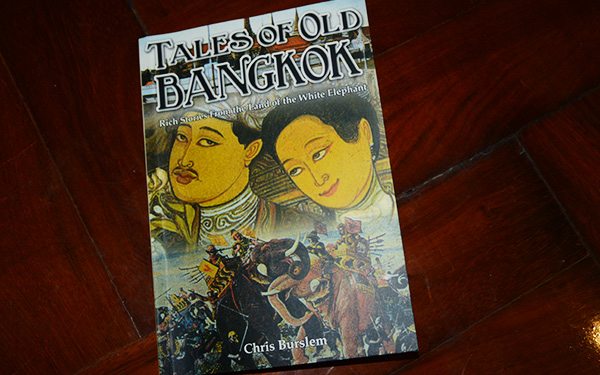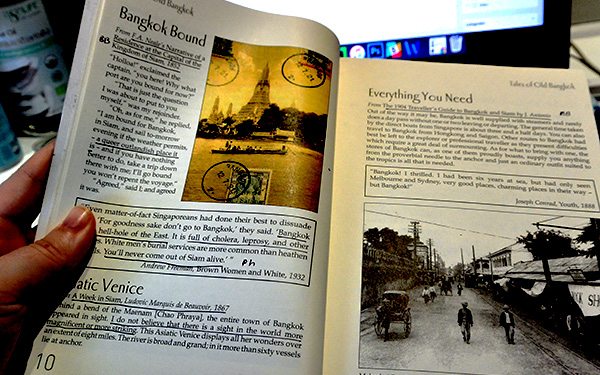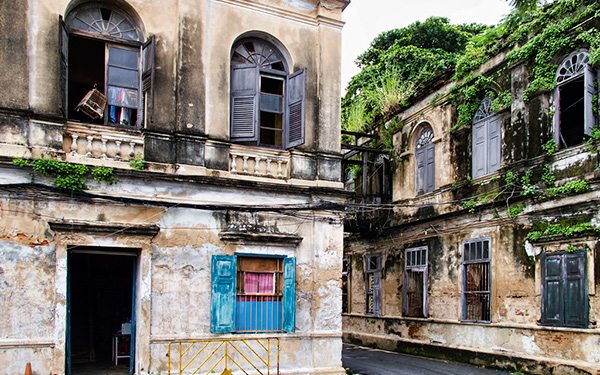The Sukhumvit Book Club is an attempt to celebrate writing, in all its forms, on Bangkok and Thailand at large – we’ll be reviewing novels, guide books, essays, literary maps, poems and essentially any writing that pertains to dear old Siam.
Whether it’s a newly published tome or Maugham’s The Gentleman in the Parlour, we’ll be reading it and writing about it.
If you’ve written something on Bangkok, published or unpublished, and would like us to review it, please email contact@whatsonsukhumvit.com.
Anyway, on to our next book…
Tales of Old Bangkok: Rich Stories from the Land of the White Elephant
Chris Burslem
EARNSHAW BOOKS LTD., 2012

Tales of Old Bangkok is an absolute treasure trove of — you guessed it — stories from Bangkok’s past.
Essentially, it’s a well-organised collection of scraps from all manner of literature written about the city, as well as photography, stamps, maps and other artwork. It’s probably the most comprehensive anthology of Bangkok impressions ever.
These impressions are all from the early foreign visitors to the city who documented their opinions and anecdotes via books, diaries, letters, telegrams, newspaper clippings and other such media. Those featured include English governess Anna Leonowens, author Joseph Conrad, British Judge H P Wilkinson, American doctor Malcolm Smith, consuls, missionaries and many more.
And when I say ‘foreign visitors’, I mean the predominantly white men who lived, worked and visited Bangkok in the 19th and 20th centuries. Sure, Thailand was never colonised, but the Europeans who started arriving at her shores in the 19th Century had some pretty colonial attitudes.
Throughout the book, this attitude is captured in their language and rhetoric. It would be anachronistic to decry them as racist, but their apparent classification of the Thai natives as “other” is quite shocking when read in the context of today.
The Thais are variously described as “our less enlightened neighbours”, “children all their lives” and “uncouth beings”, while the Chinese immigrants of the city are even more demeaningly termed “coolies” and “Chinamen”.
But regardless of these attitudes, Thailand has always stood on her own two feet and this defiance against Western influence is one of the overarching themes of the book.
Rev. Charles (Karl) Gützkaff wrote in 1834 (my bolding),
Under a good government, [Siam] might be superior to Bengal and Bankok will outweigh Calcutta. But Europeans have always been treated there with distrust and even insolence…
The huge valley of differences between the Thais and the Western men who visited their land is also described in detail via various anecdotes of the visitors.
For instance, in a record by WSW Ruschenberger from the first US diplomatic mission to Siam in 1830s, he described being denied passage to Bangkok at a Siamese port, with the captain telling the US delegation
“Your laws are different from those of Siam, the same as between heaven and…” – looking significantly and at the same time pointing downwards.
There’s also plenty of thoughts on what it means to be an expat in Bangkok, and the struggles of assimilation in the city.
She may have been writing in 1950, but US housewife’s Carol Hollinger’s views ring true even today:
No Westerner comprehends an Oriental country because he has lived there a few years. Even those who spend a decade or so in the East and who go ostentatiously native are deluding themselves they know the country.
And in a 1949 edition of Life, it’s clear that in some ways, nothing changes in this city:
people are more accustomed to coups d’état than they are to Coca-Cola.
This is compounded by tales about other seemingly timeless features of Bangkok.
Sure, there may be more skyscrapers and public transport now, but the bad traffic, soi dogs, flesh trade and intense smells have seemingly always been in situ if this book is anything to go by!
But while Tales of Old Bangkok documents the uneasy relations between East and West as the latter try to find their position in the city, it also clearly shows the start of the West’s long-lasting love affair with Bangkok and the charm the city held for its visitors even hundreds of years ago.
Ludovic Marquis de Beauvoir wrote of the city in 1867,
I do not believe that there is a sight in the world more magnificent or more striking.
Of the Thai people, Bernard Kalb said in a 1961 edition of the New York Times,
the people seem to have found the magic elixir. Life, a visitor feels has not been wasted on the Thais.
But Tales of Old Bangkok is more than just a collection of anecdotes and memories – it also offers up a rich slice of Bangkok’s history, with plenty said about the history of the royal family, 20th Century politics and smaller subjects too, like the history of the Thai flag, the disappearance of Jim Thompson, and the tale of the Siamese twins.
There’s new information and perspectives offered on every page; as well as a liberal dose of artwork to reminisce over.

At just 172 pages and presented as scrapbook-style, Tales of Old Bangkok is a very easy yet rewarding read.
It’s written as one-page-one-topic, and the original source material is either presented as stand-alone or with concise and helpful commentary from Burslem.
All in all: a wonderful book.
You can buy Tales of Old Bangkok on Amazon.
Featured image is of the Old Customs House from the 1890s. By Dan Lundberg and used under a Creative Commons licence
** Disclaimer: This site is part of the Amazon affiliate program. We earn commission for purchases made through our links. This does not affect the price you pay.**



1 Comment
Pingback: Transport In Bangkok: The Highs, The Lows, The Motorbikes | WOS